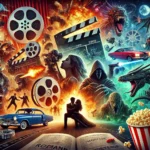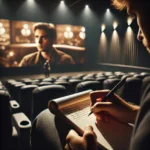Cinematography is often described as the heart and soul of filmmaking. It’s the art of capturing moving images and shaping the visual narrative of a film. While a well-written script and strong acting performances are crucial, cinematography is what visually brings the story to life. The right framing, lighting, and camera movements can evoke emotion, build tension, or offer a moment of reflection.
The work of a cinematographer, or Director of Photography (DP), goes beyond simply recording footage. It involves the deliberate use of camera techniques to craft a visual language that complements the story. Whether it’s the epic landscapes of a sci-fi blockbuster or the intimate close-ups of a romantic drama, cinematography has the power to draw the viewer deeper into the film’s world.
In this article, we’ll explore essential techniques that every aspiring cinematographer should know. From framing and composition to lighting and camera movement, you’ll learn how to apply these concepts to enhance your storytelling through the lens.
Understanding Cinematography: The Language of Visual Storytelling
Cinematography is more than just creating beautiful images. It is, at its core, a form of visual storytelling. Every decision a cinematographer makes — the angle of the camera, the type of lens, the lighting setup — contributes to how the story is conveyed to the audience. This is why understanding the fundamentals of cinematography is so important for filmmakers.
Framing, for example, determines what the audience sees and, more importantly, what they don’t see. By selectively focusing on certain elements in a scene, the cinematographer can guide the viewer’s attention and influence their emotional response. Composition is another vital element. Using tools like the rule of thirds or leading lines, the cinematographer can create balanced, aesthetically pleasing shots that serve the narrative.
Lighting also plays a significant role. Whether you’re using natural light or an elaborate lighting setup, how you illuminate your scene can completely change its mood. Harsh, high-contrast lighting can create suspense and tension, while soft, warm lighting can evoke comfort and intimacy.
Great cinematographers like Roger Deakins (known for Blade Runner 2049 and 1917) or Emmanuel Lubezki (renowned for his work on The Revenant and Gravity) are masters of visual storytelling. Their ability to use light, color, and composition transforms simple scenes into powerful cinematic moments. By studying the work of these masters, aspiring filmmakers can learn how to use cinematography as a storytelling tool.
Key Cinematography Techniques
Framing and Composition
Framing is about choosing what appears on screen and how it’s arranged within the shot. One of the most basic — but effective — tools for composition is the Rule of Thirds. This technique divides the screen into nine equal parts using two horizontal and two vertical lines. Placing your subject along these lines or at their intersections often results in a balanced and engaging shot.
Another tool is Leading Lines, which guide the viewer’s eye toward a specific point in the frame. These could be literal lines (like roads or railways) or more subtle visual cues like light or shadows. Symmetry and Asymmetry are also powerful compositional tools that can evoke balance or tension within a scene.
Framing within framing — using elements of the environment (like doorways, windows, or mirrors) to “frame” your subject — can create depth and focus in a shot, drawing attention to particular aspects of the scene.
Lighting
Lighting is one of the most expressive tools in a cinematographer’s toolkit. The Three-Point Lighting System is a fundamental technique that consists of three main lights: the Key Light (the primary source of light), the Fill Light (which softens the shadows), and the Back Light (which separates the subject from the background). This setup is versatile and helps to define the subject clearly.
However, more advanced cinematographers often experiment with light to create specific moods. For instance, high-key lighting (bright, with minimal shadows) is common in comedies and lighter films, while low-key lighting (deep shadows, high contrast) is typical of dramas and thrillers. A famous example of lighting used to dramatic effect is the shadowy, neon-lit world of Blade Runner 2049.
Natural lighting, when available, can also be a powerful tool. Films like The Revenant made extensive use of natural light to create a more immersive and realistic atmosphere.
Camera Movement
Camera movement can completely transform how a scene feels. A static shot might convey calm or stillness, while dynamic movements like pans, tilts, and tracking shots can build tension or excitement.
A tracking shot — where the camera moves with the subject — is an excellent way to create a sense of continuity and immersion. It’s often used in action scenes or when following a character through a long, continuous take, as seen in films like 1917.
Dolly shots (where the camera moves closer or further from a subject) can be used to reveal information or highlight emotional moments, while a handheld camera can inject a sense of urgency or realism into a scene, making the audience feel as though they are right there with the characters.
Depth of Field
Depth of field refers to the range of distance that appears sharp in an image. A shallow depth of field (where only a small part of the image is in focus) can isolate a subject and draw attention to it, creating a sense of intimacy or importance. This is often used in dialogue scenes where the focus is on the actor’s expressions.
A deep depth of field, on the other hand, keeps more of the scene in focus and is useful for wide shots or establishing shots where the environment is as important as the characters.
Pro Tips for Aspiring Cinematographers
- Plan Ahead: The importance of storyboarding can’t be overstated. Mapping out your shots in advance allows you to make more informed decisions on set and ensures you don’t miss any critical angles or moments.
- Experiment with Angles: Don’t be afraid to experiment with different camera angles. Shooting from a low angle can make your subject appear powerful, while a high angle might make them seem vulnerable. Tilted or Dutch angles can add tension or disorientation.
- Use Natural Light: Learn to use natural light to your advantage, especially if you’re working with a limited budget. Golden hour (the hour after sunrise or before sunset) provides soft, warm lighting that is perfect for capturing beautiful outdoor shots.
- Tell a Story with Each Shot: Cinematography isn’t just about aesthetics; it’s about storytelling. Every shot should serve a purpose, whether it’s to build tension, reveal information, or evoke a specific emotion.
- Stay Updated with Technology: Cinematic tools are constantly evolving. New technologies like drones, gimbals, and advanced camera stabilization equipment allow for smoother, more dynamic shots that were once difficult to achieve. Stay updated and be ready to incorporate these tools into your projects.
Conclusion
Cinematography is a blend of technical skill and creative vision. It’s not just about capturing images; it’s about using those images to tell a story that resonates with the audience. By mastering techniques such as framing, lighting, camera movement, and depth of field, you can elevate your filmmaking to new heights.
Whether you’re working on a small independent project or a large-scale production, the principles of good cinematography remain the same. With practice and experimentation, you’ll develop your own unique visual style and learn to communicate through the lens in ways that captivate and engage your audience.
Keep exploring, keep experimenting, and remember that every frame is an opportunity to tell a story.


